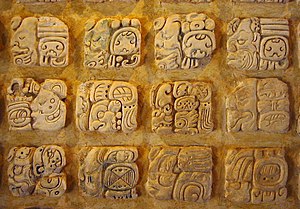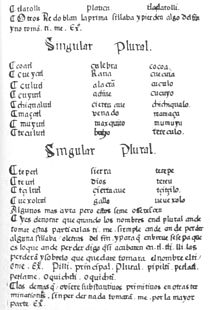Mesoamerican languages
The dominant Mesoamerican socio-cultural pattern through millennia has been centered around the town or city as the highest level community rather than the nation, realm or people.This is the case for example for the Mixtecan, Zapotecan and Nahuan linguistic groups, which all contain distinct languages that are nonetheless referred to by a single name.This is the case of the Mayan languages, with an internal diversity that is arguably comparable to that found between the Nahuatl dialects, but many of whose linguistic varieties have separate names, such as Kʼicheʼ, Tzotzil or Huastec.One such subarea would be the Maya area, roughly covering the Yucatán Peninsula, Guatemala, Belize, Chiapas and Tabasco, where Mayan languages have been highly predominant.Another linguistic area is Oaxaca, which is dominated by speakers of Oto-Manguean languages, mainly Mixtec and Zapotec, both of which are extremely internally diverse.Based on toponymy, it is possible that Xincan languages were originally spoken in western El Salvador, but were replaced by Nawat after postclassic migrations.The Guerrero subarea has been home to the Oto-Manguean Tlapanec and the unclassified Cuitlatec, and later Nahuatl, as well as a handful of undocumented languages along the Costa Grande.Linguistic data, however, including language reconstruction derived from the comparative method, do not reach further back than approximately 5000 years (towards the end of the Archaic period).The splitting of Proto-Mayan into the modern Mayan languages slowly began at roughly 2000 BCE when the speakers of Huastec moved north into the Mexican Gulf Coast region.While the Maya actually left examples of their writing, researchers have been unable to determine the linguistic affiliations of several important Classic civilizations, including Teotihuacan, Xochicalco, Cacaxtla, and El Tajín.During this time Oto-Manguean groups of central Mexico such as the Chiapanec, Chorotega and Subtiaba migrated south some of them reaching the southern limits of Mesoamerica in El Salvador and Nicaragua.In the early Postclassic period feuds between royal lineages in the Yucatán Peninsula caused the forefathers of the Itza' to move south into the Guatemalan jungle.In northwestern Oaxaca speakers of Mixtec and Chocho-Popolocan languages built successful city-states, such as Teotitlan del Camino, which did not fall under Nahuan subjugation.The first victim of this process was the native writing systems which were banned and prohibited and the existing texts destroyed – the pictorial scripts were seen as an idolatry by the Catholic Church.And missionary grammarians undertook the job of writing grammars for the indigenous languages in order to teach priests.[19] This put an end to the teaching of and writing in indigenous languages and began a strict policy of hispanization of the Indians.However the fact that today around five million people in Mesoamerica still speak indigenous languages suggest that this policy wasn't as effective after all.[20][21] Indigenous languages have been seen by the governing classes as a hindrance to building homogeneous nation states and as an impediment to social progress.Five or six different scripts have been documented in Mesoamerica but archaeological dating methods make it difficult to establish which was earliest and hence the forebear from which the others developed.First, the fact that native populations in Mesoamerica were the first to interact with Europeans assured the documentation and survival of literature samples in intelligible forms.Some important literary works in Mesoamerican languages are: The mythological narrative of the Popol Vuh and the theatrical dance-drama the Rabinal Achí both written in Classical Kʼicheʼ Maya.[24] The traits defining the Mesoamerican sprachbund are few but well established: the languages use relational nouns to express spatial and other relations, they have a base 20 (Vigesimal) numeral system, their syntax is never verb-final and as a consequence of this they don't use switch reference, they use a distinct pattern for expressing nominal possession and they share a number of semantic calques[24]].





Maya glyphsPalenqueMesoamerican writing systemlanguagesindigenousMesoamericanGuatemalaBelizeEl SalvadorHondurasNicaraguaCosta RicadiffusionsprachbundMesoamerican Linguistic AreawritingZapotecarrival of the SpanishLatin scriptOto-MangueMixe–ZoqueTotonacanUto-AztecanChibchan languagesPurépechaTequistlatecXincanLencanendangered or already extinctMayan languagesNahuatlMixtecdialectsaltepetlendogamylingua francaClassical NahuatlClassical Mayanomadic“chaining”isoglossesPopolucaChichimecaIsthmus-Mecayapan NahuatlZoogocho ZapotecUsila ChinantecNahuatl dialectsKʼicheʼTzotzilHuastecGeography of MesoamericaYucatán PeninsulaChiapasTabascoMixe-ZoqueChiapanec languageOaxacaOto-Manguean languagesTequistlatecanPochutec languageIsthmus of TehuantepecValley of MexicoOto-Pamean languagesMatlatzincaMazahuaMichoacánHuicholNayaritWestern Peripheral NahuatlJaliscoColimaJalisco OtomiJalisco ZapotecChichimecTepimanCoracholTotonacan languagesMixe–Zoque languagesIsthmus NahuatlXincan languagesSubtiabaMangueNicoya PeninsulaIsthmo-Colombian areaMisumalpanChibchanTlapanecCuitlatecCosta Grandepre-ColumbiancolonialMesoamerican chronologyPaleo-Indiancomparative methodarcheologicalethnohistoricalproto-languagesMixe–Zoquean languagesProto-Oto-MangueanProto-MayanProto-Mixe–Zoqueancomplex societyOlmec civilizationEarly PreclassicagriculturereligionOlmec influences on Mesoamerican culturesZapotec cultureGulf Coast regionUto-Aztecan languageshunter-gatherersCoracholanTeotihuacanXochicalcoCacaxtlaEl TajínTilantongoMonte AlbánValley of OaxacaClassic Ch'olti'anTerrence KaufmanNahuanUto-Aztecan languageChiapanecChorotegaPochutec